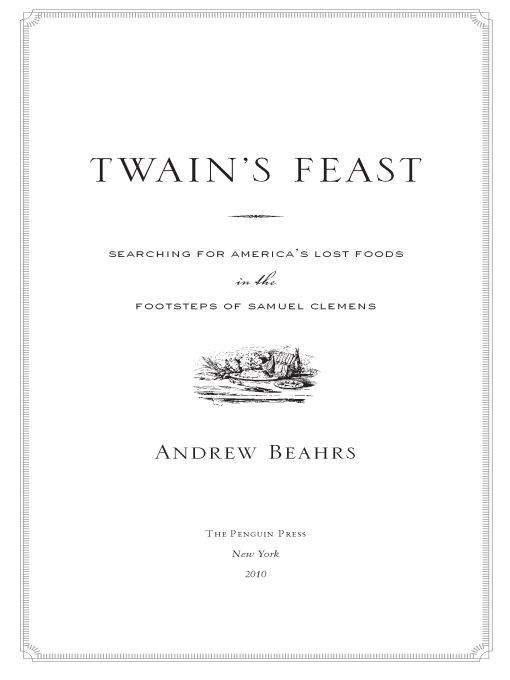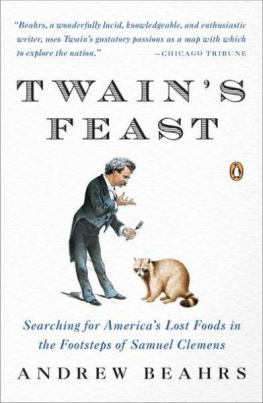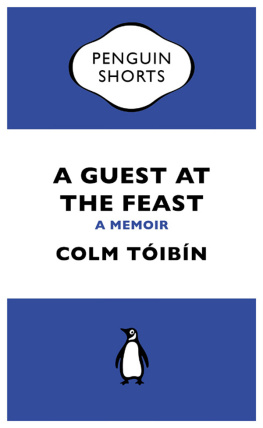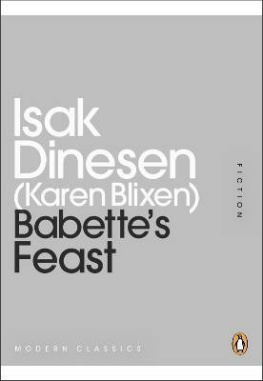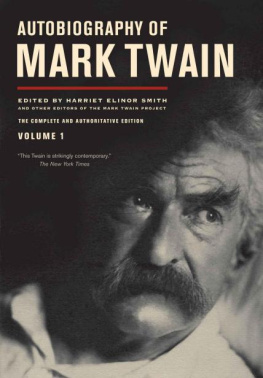Table of Contents
For Erik and Mio
IF I HAVE A TALENT IT IS FOR CONTRIBUTING VALUABLE MATTER TO WORKS UPON COOKERY.
Mark Twain
INTRODUCTION
FOR MY THIRTY-THIRD BIRTHDAY, I wanted breakfast with Mark Twain. Id been preparing for more than a weekreading Twains novels, digging through old cookbooks, shopping in a half dozen markets. Now a two-inch-thick, dry-aged porterhouse rested on my kitchen counter in a nest of brown butcher paper. Buckwheat batter and a tray of biscuits waited for the oven; dark maple syrup warmed in a small saucepan. In the living room, my wife had our three-year-old son pinned down (literally, I hoped). Beside me a deep, seasoned-to-black cast-iron fryer heated over the highest possible flame.
I owed my planned menu to Twains painful homesickness. In the winter of 1879, he was more than a year into the European tour chronicled in A Tramp Abroad. Along the way hed mocked the pretensions of Alpine expeditions, the absurdity of French duels, the awful German languageand the food, most of all the food. He detested the food. From watery coffee to decayed strawberries to chicken as tasteless as paper, Twain thought European food monotonous, a hollow sham, a base counterfeit. There is here and there an American who will say he can remember rising from a European table dhte perfectly satisfied, he wrote. But we must not overlook the fact that there is also here and there an American who will lie.
So Twain dreamed of American dishes, from peach cobbler and simply dressed tomatoes to oyster soup and roast beef. But he dreamed first of breakfast. He imagined an angel, suddenly sweeping down out of a better land, and setting before an American exile a mighty porterhouse steak an inch and a half thick, hot and sputtering from the griddle; dusted with fragrant pepper; enriched with little melting bits of butter of the most unimpeachable freshness and genuineness;... a great cup of American home-made coffee, with the cream a-froth on top,... some smoking hot biscuits, [and] a plate of hot buckwheat cakes, with transparent syrup. He concluded wistfully: Could words describe the gratitude of this exile?
Id known at once that Id make the breakfast; for me, cooking and reading blend like a chicken-fat roux. When Ishmael writes of savory clam and cod chowders, or of frying ships biscuits in the try-pots, I linger; I return to The Adventure of the Blue Carbuncle (Sherlock Holmes finds a gem hidden in a roasting goose) and Breakfast (Steinbeck eats breakfast) more often than the stories deserve. After roasting a pig, Ill gnaw the tail and think of Laura Ingalls Wilders autumn butchering. Ive cooked snails from my backyard with butter, garlic, and prosciutto, raising the first from the broth to salute those that sent Italo Calvinos young Baron Cosimo into the trees (my wife threatened to follow his example). Ive cooked prawns from Hemingway, steaks from Joseph Mitchell, and gumbo from Least Heat-Moon.
So it seemed inevitable, after reading A Tramp Abroad, that Id cook Twains breakfast. Id make the first meal he thought of, when he thought of home.
Twain described his ideal steak as though he were mapping his own home countryhe wrote of a county of beefsteak, of townships of fat, of districts separated by bone. When I looked at the meat on my counter, I could see why. This was no uniform, sterile cut; it had heft, authority, presence. The mottling of meat and fat declared that no two bites would be alike.
Wanting a steak as much as possible like those Twain enjoyed, I ordered a grass-fed, dry-aged porterhouse from a small local butcher. Raising cattle on grass makes both biological and environmental sense, requiring vastly less oil and water than is needed to grow enough grain for a large ruminant. More important for my purposes, Twains steaks were invariably from cattle raised on pasture. Until cattle were forcibly moved to a diet of corn, the sometimes rich, sometimes gamy taste of beef fed exclusively on grass was simply what beef tasted like.
Similarly, its likely that every steak Twain ever ate was dry-aged, hung in a cool, dry spot for the three to five weeks necessary for the proteins to begin to break down and the flavor to ripen. Wet aginga cheaper, faster process that begins with packing meat in plasticleaves the steak with more of its original weight; dry aging can give it an aroma as smooth as old wine.
I had an urge to brag. I imagined myself calling up relatives or knocking on neighbors doors. Instead I rubbed the meat with a fistful of kosher salt. Soon it was sizzling in the pan; Id finish it in a hot oven.
Some smoking hot biscuits, Twain wrote. Some real butter, firm and yellow and fresh. I was using a biscuit recipe given to me by an archaeology graduate student on the Virginia corn-and-peanut plantation where I excavated during college summers. The recipe always reminds me of a thunderstorm that turned the air purple and sent lightning crashing along the James River as we feasted, after a long week of digging out colonial bottles and pipe stems, on angel biscuits, blue crabs, and beer. Id considered making beaten biscuitsslamming the dough with a rolling pin until it blistered and needed no leavening. But using the Virginia recipe instead was a sympathetic nod to Twains nostalgia, which, by the time he wrote his fantasy menu, was both intense and introspective. Hed published the semiautobiographical Tom Sawyer only a few years prior, and had begun to draft Huckleberry Finn; soon Life on the Mississippi would revisit his years of young manhood. Thinking of each well-loved place must have made him long for the foods hed eaten there. I knew it did for me.
The butter was from a local farmers market, churned and shaped into an irregular log only the day before. I dipped in the tip of a knife, touched it to my tongue, and... well, you know whats better than sweet, fresh butter? Not a whole lot. Fresh butter melting on a steak, maybe.
A plate of hot buckwheat cakes, with transparent syrup. This was a harder one. Making flapjacks would complicate the timing of the steak, biscuits, and coffee, which I planned to brew in a French press at the last minute. I found a solution in The Confederate Housewife, a compilation of recipes printed in Southern newspapers during the Civil War. Though the buckwheat-cake recipe was serenely confident, concluding with a simple, imperious try it, the truth is that the instructions seemed off, calling for neither leavening nor salt. Still, the cake had the advantage of being baked, instead of cooked on a griddle; Id be able to finish the entire meal in the oven, making the timing immeasurably easier. Besides, I mostly wanted the cake to serve as a base for dark maple syrup.
Twain wanted his syrup transparent, probably the grade called light amber, or fancy. But I like maple syrup dark. One of my earliest memoriesnot just food memories but memoriesis of boiling sap in a lean-to at my Connecticut-hippie nursery school. Its an intensely sensory memory of melting snows, and cold spring air swirling into the smoky boiling house, and steam pouring from a slowly sweetening kettle of syrup. Most of all its a memory of maplemaple sipped from a wooden ladle, maple boiled until it seemed, to my four-year-old tongue, to be dark as night and sweet as the heart of the tree.

